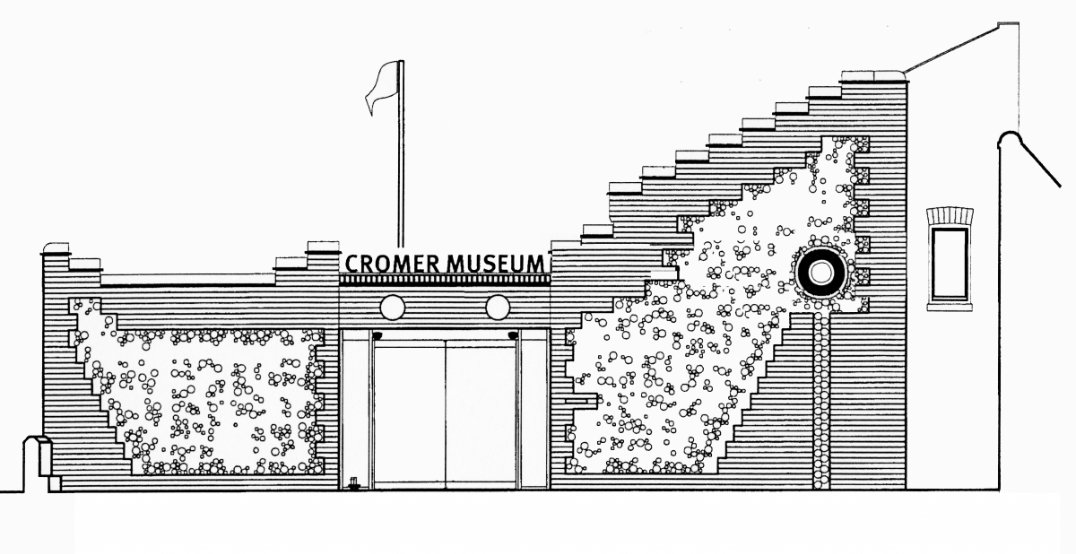Sir Aubrey Strahan
 A magic lantern slide labelled "Large Chalk Boulder, Cromer, by A. Strachan", probably taken in 1897. It was photographed for "British Geological Association Photos".While not a collector, Aubrey Strahan comes into the north Norfolk story through his photography of features of the cliffs when visiting in the late 1890s. What appeared to be a rather less than interesting magic lantern slide of a “large chalk boulder, Cromer” led to a number of other photographs now in the collection of the British Geological Survey. The slide credits the photo to Strahan and we can assume that it was one of a set which he used to make presentations about the cliffs of Cromer and district.
A magic lantern slide labelled "Large Chalk Boulder, Cromer, by A. Strachan", probably taken in 1897. It was photographed for "British Geological Association Photos".While not a collector, Aubrey Strahan comes into the north Norfolk story through his photography of features of the cliffs when visiting in the late 1890s. What appeared to be a rather less than interesting magic lantern slide of a “large chalk boulder, Cromer” led to a number of other photographs now in the collection of the British Geological Survey. The slide credits the photo to Strahan and we can assume that it was one of a set which he used to make presentations about the cliffs of Cromer and district.
Family and Education
Sir Aubrey Strahan (1852–1928) was a distinguished British geologist whose contributions to geological surveying and mineral resource mapping have left an indelible mark on the field. Born in London on April 20, 1852, Strahan was the fifth son of William Strahan and Anne Dorothea Strahan. His early education took place at the Rev. W. T. Browning's school in Thorpe Mandeville, Northamptonshire, and later at Eton, where he developed an interest in natural sciences, winning a prize for Chemistry.
Strahan's academic journey continued at St. John's College, Cambridge, where he was influenced by the Rev. Osmond Fisher, a relative and prominent geologist. He graduated in 1875 and soon after joined the Geological Survey of Great Britain under Professor Sir Andrew Ramsay. His initial fieldwork took him to South Lancashire and Cheshire, where he began to hone his skills in geological surveying.
Surveying Career
Throughout his career, Strahan conducted geological surveys across various regions of Britain, including South Wales,  Srahan on a field trip, later Sir Aubrey Straham as Director of the British Geo;ogical; Survey. Courtesy of the British Geological Survey. Source: BGS GeoScenic (image P575832)Lincolnshire, the Isle of Wight, and Cumberland. His meticulous fieldwork and detailed geological maps were instrumental in advancing the understanding of geological formations and their economic implications. One of his notable contributions was the extensive survey of the South Wales Coalfield, which provided valuable insights into coal seams and their potential for mining.
Srahan on a field trip, later Sir Aubrey Straham as Director of the British Geo;ogical; Survey. Courtesy of the British Geological Survey. Source: BGS GeoScenic (image P575832)Lincolnshire, the Isle of Wight, and Cumberland. His meticulous fieldwork and detailed geological maps were instrumental in advancing the understanding of geological formations and their economic implications. One of his notable contributions was the extensive survey of the South Wales Coalfield, which provided valuable insights into coal seams and their potential for mining.
Strahan's work in Lincolnshire involved assisting in the completion of the last of the Ordnance Survey 1-inch maps, contributing to the broader geological mapping efforts in the region. His surveys in the Isle of Wight and Purbeck included revising geological maps and studying formations, further enhancing the geological knowledge of these areas. In Cumberland, he examined mines and contributed to geological memoirs on coal measures, adding to the understanding of the region's mineral resources.
Noted for his Use of Photography
In addition to his geological expertise, Strahan had a keen interest in photography, which he used to document geological features and landscapes. His photographic work was recognized as part of his contributions to the Geological Survey, aiding in the visual representation of geological formations. Although specific examples of his geological photography are limited, it is evident that his use of photography played a role in capturing and documenting geological features for study and reference.
 Contorted drift photographed by Strahan "about half a mile west of Cromer". Courtesy of the British Geological Survey. Source: BGS GeoScenic (image P235674)It is through his photography that we have the record of his visit to Cromer and district. The Geoscience image resource yields a selection of pictures when searching by his surname, and he evidently made the journey along the beach with what would have been a substantial camera. As can be seen, the "Large chalk boulder: Cromer" indicates it was used in the British Associations annual report of 1898, which suggests a visit in 1897. The magic lantern slide of that picture has is initials written onto the glass and his surname rinted on the label.
Contorted drift photographed by Strahan "about half a mile west of Cromer". Courtesy of the British Geological Survey. Source: BGS GeoScenic (image P235674)It is through his photography that we have the record of his visit to Cromer and district. The Geoscience image resource yields a selection of pictures when searching by his surname, and he evidently made the journey along the beach with what would have been a substantial camera. As can be seen, the "Large chalk boulder: Cromer" indicates it was used in the British Associations annual report of 1898, which suggests a visit in 1897. The magic lantern slide of that picture has is initials written onto the glass and his surname rinted on the label.
Director of the Geological survey Strahan's leadership abilities were recognized when he was appointed Director of the Geological Survey in 1914, a position he held until his retirement in 1920. During his tenure, he focused on aligning geological research with national interests, particularly in resource management. His efforts were instrumental in advancing geological research and ensuring that the Geological Survey remained at the forefront of geological studies.
Geological Memoirs
Throughout his career, Strahan authored over 30 geological memoirs, many of which detailed the areas covered by individual sheets of the Geological Map. His publications included detailed descriptions of coalfields and mineral resources, as well as reports on Britain's mineral resources during World War I. His academic contributions extended to numerous papers published in geological journals, focusing on economic geology and mapping techniques.
In spite of the numerous papers that were published of his many visits around Britain, we have not been able to track down a written record of his outing to north Norfolk. The British Geologlcal Survey holds a field notebook covering the years when he evidently visited the Sheringham to Trimingham area, and further research is needed to see if this carries useful information.
Strahan's contributions to geology were recognized with several prestigious awards. In 1919, he was awarded the Wollaston Medal, one of the highest honours in the field of geology. He was also elected a Fellow of the Royal Society in 1903 and served as President of the Geological Society of London from 1913 to 1914. His leadership and contributions to the field were further acknowledged with an honorary degree of LL.D. from the University of Toronto.
Legacy
On a personal note, Strahan married Fannie Roscoe in 1886, and they lived in Goring-on-Thames until his death in 1928. His legacy in the field of geology is marked by his meticulous fieldwork, detailed geological maps, and significant contributions to the understanding of coalfields and mineral resources. Strahan's work has left a lasting impact on the field of geology, and his contributions continue to be recognised and valued by geologists and researchers today.
Sir Aubrey Strahan's life and work exemplify the dedication and passion of a geologist committed to advancing the understanding of geological formations and their economic implications. His careful fieldwork, leadership, and contributions to geological surveying have left an enduring legacy in the field of geology.




